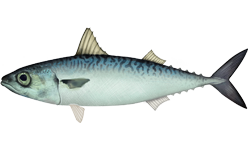Chub mackerel
| Chub mackerel Temporal range: Pliocene - Recent |
|
|---|---|
 |
|
| Scientific classification | |
| Kingdom: | Animalia |
| Phylum: | Chordata |
| Class: | Actinopterygii |
| Order: | Perciformes |
| Family: | Scombridae |
| Genus: | Scomber |
| Species: | S. japonicus |
| Binomial name | |
|
Scomber japonicus Houttuyn, 1782 |
|
The chub mackerel, Pacific mackerel, or Pacific chub mackerel (Scomber japonicus) is a mackerel which closely resembles the Atlantic chub mackerel.
The chub mackerel has a well-developed swim bladder attached with the esophagus, which the "true mackerels" in the Scomber genus lack, and a characteristic color difference is seen between the chub and the Atlantic chub, the latter being silvery-sided below the midline, whereas the lower part of the sides of the chub (otherwise colored somewhat like the Atlantic) are mottled with small dusky blotches, and the chub has a larger eye than the Atlantic. Less obvious differences are that the dorsal fins are closer together in the chub and only 9 or 10 spines are in its first dorsal fin instead of 11 or more, which is the usual count in the Atlantic mackerel. In most species, the mackerel is known to travel in large schools. It is a smaller fish than its better-known relatives, growing to a length around 8 to 14 inches (20 to 36 cm).
Chub mackerel school like Atlantic mackerel, and their feeding habits are much the same, eating the same species of pelagic crustaceans and Sagittae that the mackerel had taken at the same time and place, while specimens taken at Woods Hole ate chiefly copepods, to a lesser extent on amphipods, salps, appendicularians, and young herring. They follow thrown bait as readily and bite quite as greedily as Atlantic mackerel do. Their breeding habits have not been studied.
Fossils of Scomber japonicus have been found in the Pliocene of Italy (age range: from 3 to 2.2 million years ago.).
Chub mackerel are widespread in the Indo-Pacific. They are absent from the Indian Ocean except for South Africa from KwaZulu-Natal to Western Cape, and are replaced by the closely related Atlantic chub mackerel in the Atlantic. The chub mackerel is widely distributed, usually found in the northwestern, southeastern, and northeastern Pacific. In the eastern Pacific, it can be found from central Mexico to southeastern Alaska. Chub mackerel are generally found within 20 miles (37 km) off the coast in waters between 50 and 72°F (10 to 22°C). Young mackerel live around sandy beaches or kelp beds, while adults are found in deeper waters in shallow banks to 1000 feet (300 m) deep. Chub mackerel school with other pelagic species, as well such as other types of mackerels and sardines.
...
Wikipedia

